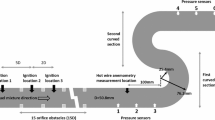Abstract
Recent progress on detonation drivers is reviewed. Performances of the forward detonation driver and backward detonation driver have been obsenred. To eliminate occurrenoe of a Taylor wave following the detonation wave in the primary driver and to improve the performance of the detonation driver, an additional backward detonation driver was proposed to attach to the end of the forward detonation driver. When the ratio of the initial pressures between the additional and the primary drivers becomes larger than or equal to a critical value, the Taylor wave will disappear, and thus a homogeneous driving gas with high pressure and high temperature can be generated. Furthermore, an over-driving detonation wave will be also obtained, which can increase the driving capability.
Similar content being viewed by others
References
Yu. H. R., Shock tunnel and its application to aero-heating experiments (in Chinese), Thesis, Institute of Mechanics, Chinese Academy of Sciences (1963).
B. H. K., Detonation driven, shocks in a shock tube, AIAA J., I% 7,5:791–792.
Gier, H. L., Jones, T. G, An investigation of a double diaphragm shmk tube with a detonating buffer gas, in Shmk Tubes (ed. Glass, 10, Toronto: University of Toronto Press, 1970, 272–290.
Edwards, D. H., Willians, G. T. Breeze, J. C., Pressuremrnd velociq measurements on detonation wava in hydro-oxygen mixtures, Fluid Mechanics J., 1959(6): 497–517.
Balmmk, M. I., Johnson M. R., The gaseous detonation driver and its application to shock tube simulation techniques, in Roceedjng srnIn t. Symp on Shock Tubes (eds. Mwlton, J. E., Filler, W. S.).). W hite Oak, Mary- land USA, American Physical Swiety (AD63801 1), 1965 1111–1119.
Coates, P. B., Gaydon, A. G., A simple shock tube with detonating driver gas, Roc. Roy. Soc., London, 1965, A283: 18–32.
Yu, H. R., Recent developments in shock tube application, Proc. of the 1989 Japan National Symposium On shmk wave phenomena, Sagamiham, Tohoku Unipress Seudai, Japan, 1989, 1–7.
Yu, H. R., Esser, B., Cenam, M. et al., Gaseous detonation driver for a shock tunnel, Shock Waves, 1992, 2(4): 245–254.
Bakos, R. I., Erdos, J. I., Options for enhancement of the performance of shock-expansion tubes and tunnels. AIAA. f995, p95–0799.
Taylor, G I., The dyndca of the combustion products behind planar and spherical detonation fronts in ex plosive, Roc. Roy. Sw., 1950, A200: 235–247.
Zel'dovich, Y. B., Distribution of pressure and velocitJl in detonation products, J. Exp, and Theor. Physics, 1942, 12: 389.
Yu, H. R., Oxy-hydrogen cambustion and detonation driven shock tube, Acta Mechanics Sinica, 1999, 15(2): 97–107.
Bird,G A., A note on combustion driven shmk tubes, RAE TN-Aero 25 11, 1957, Farnborough, England.
Bakos, R. J., Erdos, J. L., An experimental and computational study leading to new teat capabilities for the hypulse facility with a detonation driver, ATAA, 1996, p96–2193: 17–20.
Author information
Authors and Affiliations
Corresponding author
Rights and permissions
About this article
Cite this article
Chen, H., Feng, H. & Yu, H. Double detonation drivers for a shock tube/ltunnel. Sci China Ser G: Phy & Ast 47, 502–512 (2004). https://doi.org/10.1360/03yw0305
Received:
Issue Date:
DOI: https://doi.org/10.1360/03yw0305




